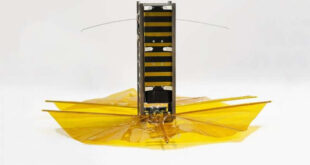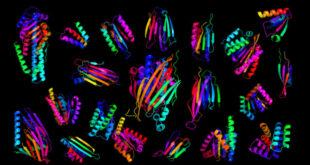Attaching curcumin — a compound found in the cooking spice turmeric — to ceria (cerium oxide) nanoparticles can be used to target and destroy treatment-resistant neuroblastoma tumor cells, according to a team of researchers led by University of Central Florida Professor Sudipta Seal.
Curcumin is a major constituent of turmeric (Curcuma longa), the main spice in the Indian dish curry. Image credit: Simon A. Eugster / CC BY-SA 3.0.
Neuroblastomas are cancers that start in early nerve cells and commonly form in the tissue of the adrenal glands, near the kidneys.
About 700 new cases of neuroblastoma are diagnosed each year in the United States and most cases appear in children younger than 5 years old.
High-risk neuroblastoma is hard to cure and is more likely to become resistant to standard therapies or recur.
Curcumin has been shown to have substantial anti-cancer ability, but its low solubility and poor stability have made its use in medicinal applications challenging.
Professor Seal and co-authors from the University of Central Florida and Nemours Children Hospital found that nanoparticles can be used to deliver curcumin to tumor sites.
“This shows that nanoparticles can be an effective delivery vehicle for cancer drugs,” Professor Seal said.
“High-risk neuroblastoma can be resistant to traditional therapy, and survival can be poor,” added co-author Dr. Tamarah J. Westmoreland, a pediatric surgeon at Nemours Children’s Health System.
“This research demonstrates a novel method of treating this tumor without the toxicity of aggressive therapy that can also have late effects on the patient’s health.”
In the study, the authors loaded ceria nanoparticles with curcumin and coated them with dextran to test in cell lines of a high-risk form of neuroblastoma, known as MYCN-amplified, as well as non-amplified neuroblastoma.
This formulation induced substantial cell death in neuroblastoma cells while producing no or only minor toxicity in healthy cells.
Overall, the nano-therapeutic treatments showed a more pronounced effect in MYCN-amplified cells, which are traditionally more resistant to drug therapies.
“Unique approaches to target tumor cells with nanoparticle delivery systems hold promise for treatment of resistant tumors, such as the high risk neuroblastoma,” Dr. Westmoreland said.
“We are hopeful that in the future, nanoparticles can be utilized to personalize care to patients and reduce the late effects of therapy.”
“More research is needed, but we are hopeful it could lead to more effective treatment of this devastating disease in the future,” Professor Seal concluded.
The findings are published in the journal Nanoscale.
_____
Irina Kalashnikova et al. Nanoparticle delivery of curcumin induces cellular hypoxia and ROS-mediated apoptosis via modulation of Bcl-2/Bax in human neuroblastoma. Nanoscale 2017 (9): 10375-10387; doi: 10.1039/C7NR02770B
 #Bizwhiznetwork.com Innovation ΛI |Technology News
#Bizwhiznetwork.com Innovation ΛI |Technology News




